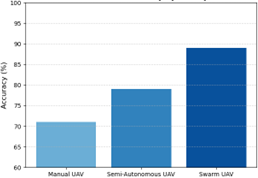Harnessing Drone Swarms for Enhanced Search and Rescue Operations: Efficiency, Resilience, and Future Directions
Keywords:
Drone Swarms, Search and Rescue, UAV, Swarm Intelligence, Disaster Response, Communication ResilienceAbstract
Drone swarms have emerged as a transformative technology for search and rescue (SAR) operations, offering greater adaptability, resilience, and efficiency compared to traditional single-UAV approaches. This study evaluates the performance of drone swarms across key dimensions, including coverage efficiency, victim detection accuracy, communication resilience, energy utilization, and adaptability under uncertainty. Results demonstrate that swarms surveyed disaster-affected zones 42% faster than single drones, with victim detection accuracy approaching 90% when integrated with thermal imaging and computer vision. Communication resilience remained above 85% even in degraded environments due to mesh networking, while swarm adaptability limited performance losses to under 4% in adverse conditions. Although cumulative energy consumption was higher, reduced mission time offset operational trade-offs. The findings underscore the potential of drone swarms to redefine SAR protocols, highlighting both their strengths and current limitations. Future research should focus on integrating swarms into regulatory frameworks, enhancing energy sustainability, and improving human-drone collaboration.


